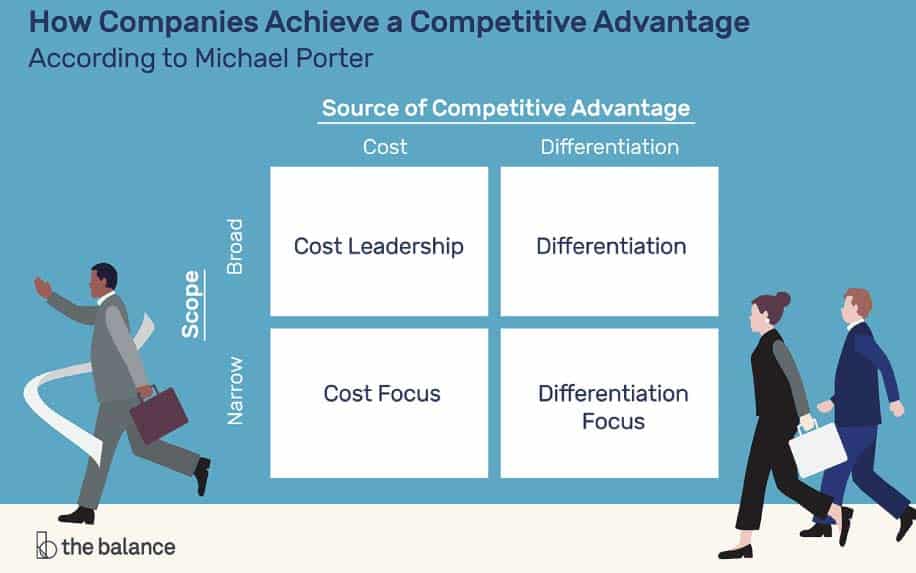Let’s explore the main types of corporate strategy. But what is a corporate strategy? How do they differ from other business strategies? Read on to find out everything you need to know.
A corporation is different from an everyday company. For starters they are much larger. Also, they are a separate legal entity from their owners. How did these corporations become so large? The short answer is they planned it over the long term.
If you own a company and all your long-term plans include surviving or increasing profits, chances are you’ll stay small. It takes extensive planning and cooperation between every department to achieve your company’s vision.
Table of Contents
What Is Corporate Strategy?
Corporate strategy is the corporate-wide direction of a business, and how they plan to achieve this. When a company has a business goal, all the departments have to work together to achieve it.
In the end any slight change in the direction or scope of a company has a ripple effect on all departments and operations. This is why a strategy has to include a sub-strategy for every department, with internal plans within each business vertical.

Most corporate strategies are related to the size of the business. Why? Because in the end the point of starting a business is to make profit. Increasing in size is one sure way to substantially increase profit.
However, not all strategies are aimed at up-scaling, but we’ll get to that.
The difference between a plan and a strategy is that a plan is temporary and small scale.
A strategy, on the other hand, encompasses everything, from product management, to marketing, to distribution. Corporate strategies are meticulously detailed steps towards a larger picture.

What are the Goals of Corporate Strategy?
Corporations and armies have a lot in common. All jokes aside, both are hierarchical, organisational entities that consist of a number of members. Members offer their skills and competencies to the benefit of the whole organisation.
Most importantly, both armies and corporations have leaders who deal with everything related to decision making. Therefore, they need a strategy to reach their goals by making the right decisions at the right time.
So, both armies and companies need a strategy to:
- Use their resources in the most effective way.
- Establish a favourable position.
In today’s world, the business environment is less predictable than ever. For that reason, analytical reasoning and strategic positioning are the most valuable assets a company should have.
Different Approaches to Corporate Strategy
It’s true that every company needs to plan its moves if they want to get anywhere. But that means first they need to figure out where they want to go.
There’s no magic key that solves all problems or guarantees increase in profits. Strategies are customisable to every company and even within a company it changes according to the current situation.
Here are some of the key situations when corporate strategy is most apparent.
1. Mergers and Acquisitions
One of the most powerful actions a company can take is to decide to take over or partner up with another business. It’s a guaranteed boost to the company size. There are many different types of mergers and acquisitions, it depends on the direction of the step.
However, there are two main types.
- Vertical move – This is when a company acquires another company in another part of the supply chain of a certain product.
- Lateral move – This is when a company acquires a similar company, most commonly a competitor, in an effort to join forces and increase their operations.
Although mergers and acquisitions are very beneficial for a business, they are a nightmare when it comes to day to day operations.
This means changing everything from advertising to production. Such a move is considered a corporate strategy not only because of the move itself, but because of the steps needed to be taken to ensure its success.
2. Market Penetration
In any competitive market, it’s all about who has the bigger piece of the pie. For that reason, companies use any means necessary to expand their customer base.
A competitive market means that there are already too many companies fighting over the same group of customers. In other words, the market is already saturated.
Simply lowering prices isn’t going to guarantee a surge in sales and profits.
People’s loyalty to a certain brand isn’t driven entirely by price. For example, there are other soda companies than Coca-Cola and Pepsi with much lower prices but still can’t compete with these major brands.
Allegedly, the one exception to this is Irn Bru, who have massive market penetration in Scotland. In fact, this is reportedly the only market anywhere in the world where Coke isn’t the most popular soft drink.
Market penetration is a corporate strategy that requires simultaneous attacks on many fronts. Massive amounts of data have to be collected on both the company history and competitors. New marketing campaigns need to be designed.
3. Market Expansion
Sometimes in a product life cycle, sales reach a dead end. No matter what we do to refurbish the product, sales just reach as high as they get. In those cases, a corporation might seek opportunities in another market entirely.
There are many ways for a business to expand its market. For instance, a product can be repurposed for other uses and marketed for them. Sometimes a product can be developed with additional features to appeal to another set of users.
Another way is to launch an entirely different product in another market that has a higher growth potential. The key here is to find which approach works best for your business.
4. Downsizing
Although no company goal would aim at decreasing the size of the business, downsizing is still an effective, widely used corporate strategy. Sometimes “shedding the waste” can actually increase profits.
Correcting previous mistakes like overproduction can save the life of a bleeding business.
Downsizing normally means wrapping up unprofitable parts of your business, and focusing on the things which actually deliver revenue.

What Makes a Great Corporate Strategy?
Before tackling the different types of corporate strategy, let’s discuss what makes a corporate strategy successful. Is there a secret recipe that successful corporations use?
By studying brands with established types of corporate strategy, such as Zara, Disney, and Coca-Cola, one finds that there are some common factors that contribute to the success.
These are the essential components of an effective corporate strategy:
1. Simple, Consistent, Long-Term Goals
This is the basis of every strategy ever made, in business or in any other aspect. All types of corporate strategies build upon business objectives. Business objectives and goals represent the destination that the company is trying to reach.
Without it, the ship is just lost at sea. This is, by no means, the way to establish a strong business organisation. A good point to remember is that within a corporate strategy, there are good objectives and bad ones.
Not all objectives are fruitful. There are some characteristics of good business objectives. These apply to all types of corporate strategy. Business objectives must be simple, consistent, and long term.
2. Resource Allocation
After defining goals and objectives, all types of corporate strategy must allocate the company’s resources. This is an essential step to determine what kind of resources the company has, and how to make the most out of them.
In addition, a corporate strategy should also qualify the resources for the objectives set. Do they match each other? What are the resources missing? And how can you enrich these resources and add new ones without exceeding the budget?
Resources are also the intermediate step that connects objectives to competitive advantage.
Every company has specific advantages regardless of its size. There are different types of resources. They could be human, like experienced management and a highly-skilled staff, or financial.
Your resources could be your physical location or premium product attributes, or even a market with growing demands. Other resources are emotional or even educational things, like your brand reputation.
3. Competitive Advantage
Competitive advantage results from combining a company’s resources with its capabilities. When these are optimally combined, they produce either a price-based competitive advantage or a differentiation-based advantage.
Different companies fight for the same customers, market share, and revenue. Therefore, when building up different types of corporate strategy, you should study both the external and internal circumstances.
Competitors are always looking for ways to differentiate themselves.
Cost structure, branding, the quality of products, the distribution network, intellectual property, and customer service are the most important advantages that companies thrive to excel at in order to become market leaders.
One thing to pay attention to is that your competitors are not just similar companies, offering similar products and services.
Anything that fulfills the need that your customers have is your competition. For example, brick and mortar retailers thought that their competition was with other brick and mortars, until Amazon showed up.

4. Business Portfolio
A business portfolio is a company’s set of investments, holdings, products, and brands. It’s an essential component of different types of corporate strategy. Your business portfolio focuses your strategies and identifies specific business questions.
5. The Role of Leadership in Corporate Strategy
Similar to armies, leadership is one of the most important factors in corporations. For that reason, different types of corporate strategy should identify the things which make effective managers and leaders.
Moreover, a corporate strategy should determine the internal structure and hierarchy of the company. The different levels of management and each department’s structure and role. Every employee in the company must understand how the company is formed.
That helps them identify themselves and know exactly how every employee’s work affects the entire corporate strategy.
Types of Corporate Strategy
With all of that in mind, here are three of the most important approaches to corporate strategy.
Types of Corporate Strategy #1: Growth Platform Strategy
Growth platform strategies seek to scale revenues to the next level of profits. Corporations achieve that through four different growth strategies:
- Market penetration,
- Market development,
- Product development,
- Diversification.
As the name implies, the market penetration strategy works by persuading your existing customers to buy more of your existing products. This is the least risky growth strategy.
The next strategy is market development. Here, the business targets new markets with its existing products.
This requires a deep analysis of the new customers you’re trying to target. The third one is product development which obviously creates or acquires new products to fulfill the needs of existing consumers that you know so well.
Finally, there’s the most risky diversification strategy, where a corporation develops a new product for a brand-new market.
Types of Corporate Strategy #2: Cost Leadership
Cost leadership is one of the types of corporate strategy that allow companies to expand. In cost leadership, a firm sets out to become the lowest-cost producer in its industry.
Huge brands such as McDonald’s and Walmart have adopted this strategy and it has made them market leaders.
Normally, companies achieve that through economies of scale, preferential access to raw materials, or even technological innovation. Although small companies may not have access to these methods, they can still use some techniques to employ cost leadership.
For instance, a small business could use one specific product or service segment as a “loss leader” strategy to get consumers in the door with a great, low-price offer and then cross-sell the high-margin products in the process.
Types of Corporate Strategy #3: Consolidation and Cooperative Strategy Partnerships
Business consolidation is the combination of several business units or several different companies into a larger organization. It refers to mergers and acquisitions. It’s one of the most successful types of corporate strategy.
Consolidation allows a company to expand to new spaces and markets without having to build things up from scratch. Additionally, it enables companies to use economies of scale and minimize costs.
Moreover, mergers and acquisitions deal with selling off brands and companies that no longer align with the organization’s vision.
Partnerships are popular, effective, and they fit small-sized companies as well. In business, winning isn’t only about pushing away all competitors. Winning also involves knowing when to make alliances and benefit from them.
Examples are everywhere. Barnes & Noble houses a Starbucks. Uber offers Spotify services as part of its services. Ford has an entire Eddie Bauer premium line of trucks and SUVs. These are all cooperative partnerships.
Corporate Strategy: Plan for Tomorrow and the Day After
Markets are constantly changing and constant planning is required for a company to simply keep its footing. If you own a computer hardware company, for example, there will be new competitors every day.
This means a constant dilution of your market share. So even if your company is the leading one in the field and well established, you still need to keep planning to get bigger and increase your sales.
That’s why in the business world there is no staying still. You’re either growing or you’re falling behind.
Case Studies: Real-World Success Stories in Corporate Strategy
Growth Strategies:
1. Market Penetration: Domino’s Pizza: Through digital ordering platforms and innovative product offerings like vegan and gluten-free options, Domino’s significantly increased market share within the pizza industry.
2. Market Development: Netflix: Expanding into international markets through localization and original content production propelled Netflix’s subscriber base and global dominance.
3. Product Development: Apple: Continuous innovation in smartphones and wearable devices, like the iPhone and Apple Watch, fueled Apple’s growth and solidified its position as a tech leader.
4. Diversification: Amazon: Moving beyond online retail into areas like cloud computing (AWS) and entertainment (Prime Video) diversified Amazon’s revenue streams and secured its position as a multifaceted tech giant.
Stability Strategies:
1. Retrenchment: Ford Motor Company: In response to financial troubles, Ford undertook strategic divestments of non-core assets and streamlined operations, ultimately leading to a financial turnaround.
2. Cost Reduction: Southwest Airlines: By focusing on operational efficiency and maintaining a single aircraft type, Southwest significantly reduced costs and sustained its competitive edge in the low-cost carrier market.
3. Divestiture: General Electric: To streamline its portfolio and focus on core businesses, GE divested various non-core industrial units, improving profitability and market perception.
4. Liquidation: Blockbuster: When faced with rising competition from streaming services, Blockbuster’s liquidation strategy, though painful, allowed for a controlled exit and minimized further losses.
Combination Strategies:
1. Samsung: Samsung combined market penetration in its core electronics segment with product development in areas like smartphones and AI, driving both growth and stability.
2. Lego: Lego successfully implemented a combination strategy of market development (entering new markets like China) and product development (Lego Friends line aimed at girls), leading to record-breaking sales.
Emerging Trends:
1. Sustainability: Unilever’s shift towards sustainable practices and ethical sourcing not only enhanced its brand image but also attracted environmentally conscious consumers, furthering its market penetration.
2. Digital Transformation: Adidas’ investment in digital platforms and personalized customer experiences helped them adapt to changing consumer behaviors and maintain relevance in the retail landscape.
3. Agile Strategy: Spotify’s embrace of an agile strategy with continuous experimentation and data-driven decision-making allowed them to rapidly adapt to evolving technologies and user preferences, solidifying their position as a music streaming leader.
FAQ: Demystifying the Corporate Strategy Maze
Q: What’s the difference between growth and stability strategies?
A: Growth strategies aim to expand your market share or revenue, like market penetration or product development. Stability strategies focus on maintaining performance or managing decline through retrenchment or cost reduction.
Q: How do I choose the right corporate strategy for my business?
A: Consider your current position, industry trends, competitive landscape, and business goals. A thorough analysis using tools like Porter’s Five Forces can guide your decision.
Q: Do I need to stick to one strategy forever?
A: Flexibility is key! Most companies employ a combination of strategies over time, adapting to changing environments and opportunities.
Q: Where can I find more information about specific corporate strategies?
A: Research case studies of successful companies, consult business publications and industry reports, or seek professional advice from strategy consultants.
Q: Can I implement a successful corporate strategy without a lot of resources?
A: Many strategies, like cost reduction or market penetration, can be implemented creatively and effectively even with limited resources. Focus on smart resource allocation and leveraging your existing strengths.
Conclusion: Charting Your Corporate Journey
Choosing the right corporate strategy can be the compass that guides your business towards success. By understanding the different types of strategies, aligning them with your unique situation, and learning from real-world examples, you can equip yourself to navigate the ever-evolving business landscape.
Remember, successful strategy is a continuous journey, not a one-time destination. Embrace ongoing analysis, adapt to changing circumstances, and most importantly, remain focused on your ultimate vision for your company.
If you want to find out more about building a sustainable business, contact ProfileTree today.


